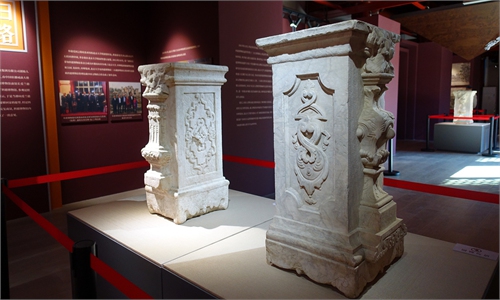ARTS / CULTURE & LEISURE
Localized heritage regulations real-life implementation of relic protection law

Illustration: Chen Xia/GT
In cities like Kunming, Southwest China's Yunnan Province, and Anqing, East China's Anhui Province, localized heritage conservation measures have recently been issued by multiple cities across China. These regulations guard sites such as archaeological ruins, ancient villages and red-culture sites with local cultural characteristics.
Kunming's regulation focuses on the Shizhaishan Ruins, a tomb cluster that represents the ancient Dian ethnic culture. The newly enacted regulation highlights various measures. It first demarcates a protection zone that encompasses the ancient tomb complex, and then also specifies construction standards for projects within the site area and defines the responsibility of relevant protection management.
The new regulation also includes forward-looking measures aiming at leveraging the site's integration to local cultural tourism, while also stipulated penalties for illegal activities relating to the regulation and the site.
The regulations mark the first ever specialized local legislation on cultural heritage protection in Kunming. Cultural policy expert Song Weiping told the Global Times that the new regulation "is a real-life implementation of China's updated Law on the Protection of Cultural Relics," noting it serves as a "stern framework for not just protection but heritage inheritance."
"To be more specific, Kunming's new policy directly responds to the updated Law stressing the improvement of the management of the cultural relics conservation system," Song noted. On March 1, the updated version of China's Law on the Protection of Cultural Relics took effect. On May 1, the enacted Kunming policy was officially put in practice.
Besides regulation focusing on archaeology being put into action, Anqing initiated a conservation policy that focuses on local traditional villages on May 1.
The newly promoted policy not only encourages formulating stricter plans for conserving Anqing's 60 traditional villages, but also explicitly notes that traditional village resources should be rationally utilized and developed. According to Pan Jiangsheng, deputy director of the Anqing Housing and Urban-Rural Development Bureau, rational utilization includes efforts such as "developing rural tourism," "launching related cultural creative programs" as well as researching local intangible cultural heritage (ICH)."
"Such measures show that China's approach to cultural heritage conservation is not static but dynamic. They also show how 'bringing heritage to life,' a principle outlined in the revised Law, is implemented in real-life cases," cultural expert Zhang Yiwu told the Global Times.
Other than focusing on heritage itself, the Anqing regulation also highlights villagers' participation and social power in conserving local heritage. The updated Law on the Protection of Cultural Relics also stresses the importance of having social forces contribute to efforts like enriching conservation funding for relics and engaging talents for heritage research.
As of 2024, China was home to more than 760,000 immovable cultural relics. To preserve these non-renewable cultural heritages, similar efforts like those in Kunming and Anqing have been gradually increasing nationwide.
In the Changji Hui autonomous prefecture, Northwest China's Xinjiang Uygur Autonomous Region, a conservation policy was recently implemented to protect the Beiting Ancient City Site. The site was a key spot along the ancient Silk Road. The new regulation calls for enhancing the site's safety and maintaining its original appearance. Meanwhile, another set of regulations were issued in Haikou, South China's Hainan Province, with the aim of protecting local sites, archives and other movable relics related to the city's red culture and revolutionary history.
"These new regulations reveal China's principle of implementing localized approaches to cultural heritage conservation," said Zhang, adding that through such new regulations, one can see the remarkable regional diversity and richness of China's cultural heritages.



